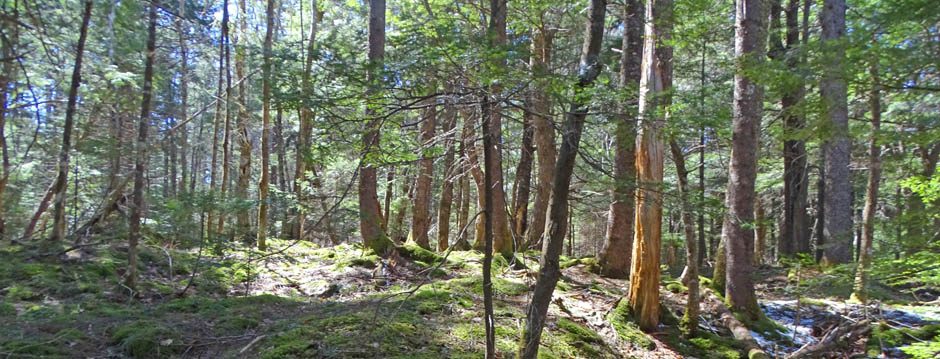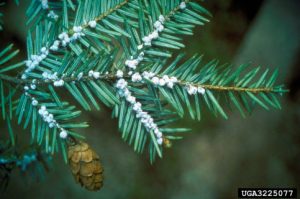
Hemlock Woolly Adelgid. “Their name comes from waxy white filaments they make to protect themselves from drying out. In a heavy infestation, hemlock trees can look gray from all the “wool” on twigs and branches. They can’t fly, but are spread by wind and also hitch rides on the feet of birds, which can carry hemlock wooly adelgids for long distances. These “hemlock vampires” were first discovered in 1951 in Virginia, and by 2005 had spread to fifteen other states.
Source: Paul Hetzler, Cornell Cooperative Extension
Photo source: Connecticut Agricultural Experiment Station, Bugwood.org
The first public announcement of the occurrence of HWA (Hemlock Wooly Adelgid) in Nova Scotia was on Aug 3, 2017.
It was then already present in three counties (Digby, Shelburne Yarmouth) and by the end of 2017 it was found in Annapolis and Queens Co., all in southwest NS. HWA populations were clearly already well past the point of eradicating them. In 202o HWA was found in Lunenburg Co. and in 2023 in Halifax and Hants Counties.

Counties of Nova Scotia (From Wikipedia)
HWA had been “detected and eradicated in Ontario in 2011 and 2013.” These were the first reports of the pest in eastern Canada; it was first reported to the south of us in the eastern US in 1951.
From NS Hemlock Initiative:
“Hemlock woolly adelgid (HWA) is an invasive, aphid-like insect native to eastern Asia and the Pacific Northwest. HWA was first reported in Canada in British Columbia in the 1920s, and it was detected in Southwestern Nova Scotia in 2017. The first Eastern North American detection was in Richmond Virginia USA in 1951, on an ornamental hemlock from Asia. It is not known at this time how HWA came into Canada, and the exact source will be difficult to determine. Dispersal of HWA occurs by wind, storms, hurricanes, birds, animals, and human movement of nursery stock, logs, and other wood products, including firewood.”
| The Nova Scotia Hemlock Initiative provides many details about HWA in NS, and what to do about it; view links to pages on their website below
|
A “Link Chronology” of HWA in Nova Scotia
Most Recent items at top
Nov 13, 2023
Halifax Councillor requests staff report on plan to address Hemlock Wooly Adelgid threat to Eastern Hemlock in HRM 13Nov2023
Post on this website
Nov 1, 2023
– N.S. pilot project pits tiny beetles against invasive insect killing Hemlock trees
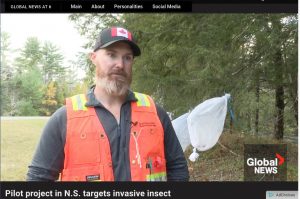 By Megan King & Rebecca Lau Global News: “…The beetle is native to Canada’s west coast, and the Canadian Forest Service is now working to introduce five beetles into a single bag alongside the Hemlock woolly adelgid to see how they fare through a Nova Scotian winter. “This beetle is essentially perfect (…) because it only attacks Hemlock woolly adelgid. It can only complete development on Hemlock woolly adelgid and it’s basically only able to find Hemlock woolly adelgid,” said Roscoe. So far, the results are immediate. Roscoe showed Global News a beetle eating a Hemlock woolly adelgid shortly after being released…Roscoe believes the pilot project will be a long-term one, that will probably take at least 10 years to see results. The goal is to release up to 3,000 beetles in areas that are warmer and where the beetles are most likely to survive. That includes Queens and Shelburne counties.”
By Megan King & Rebecca Lau Global News: “…The beetle is native to Canada’s west coast, and the Canadian Forest Service is now working to introduce five beetles into a single bag alongside the Hemlock woolly adelgid to see how they fare through a Nova Scotian winter. “This beetle is essentially perfect (…) because it only attacks Hemlock woolly adelgid. It can only complete development on Hemlock woolly adelgid and it’s basically only able to find Hemlock woolly adelgid,” said Roscoe. So far, the results are immediate. Roscoe showed Global News a beetle eating a Hemlock woolly adelgid shortly after being released…Roscoe believes the pilot project will be a long-term one, that will probably take at least 10 years to see results. The goal is to release up to 3,000 beetles in areas that are warmer and where the beetles are most likely to survive. That includes Queens and Shelburne counties.”
Oct 7, 2023
– “In The Quiet and The Dark”
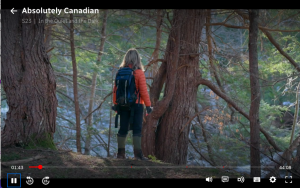 A Sea to Sea Production commissioned by CBC, 44 min. 0n CBC Gem, Featured on CBC Television Oct 7, 2023. For some background, related interviews, view Morning File (Hfx Examiner) for Sep 19, 2023: In the Quiet and the Dark: “New documentary on the people trying to save eastern hemlocks from total devastation”; also CBC Mainstreet for Oct 6, 2023 in which CBC’s Alex Mason spoke with Nance Ackerman, the film’s director.
A Sea to Sea Production commissioned by CBC, 44 min. 0n CBC Gem, Featured on CBC Television Oct 7, 2023. For some background, related interviews, view Morning File (Hfx Examiner) for Sep 19, 2023: In the Quiet and the Dark: “New documentary on the people trying to save eastern hemlocks from total devastation”; also CBC Mainstreet for Oct 6, 2023 in which CBC’s Alex Mason spoke with Nance Ackerman, the film’s director.
Aug 11, 2023
– Hemlock Wooly Adelgid now in the Halifax area
Post on www.versicolor.ca/sandylakebedford Message received from HWA Working Group -HWA Detection in Nova Scotia. “In early August, the CFIA received a report of a suspected Hemlock Woolly Adelgid (HWA) infestation on a home owner’s property in Bedford, Nova Scotia. The resulting laboratory analysis of samples taken by CFIA during follow-up has confirmed the presences HWA.”
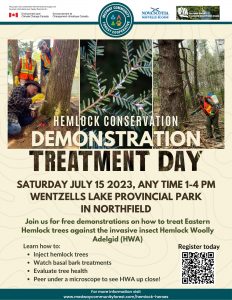 Jul 11, 2023:
Jul 11, 2023:
– Sat Jul 15, 2023: Hemlock Treatment Demonstrations Day
Post on www.versicolor.ca/sandylakebedford on July 11, 2023.”A Hemlock Conservation Demonstration Day is being held on July 15 at Wentzell’sLake provincial park in Northfield, Lunenberg Co. Registration is required”
Mar 25, 2023
– Please be on the lookout for Hemlock Wooly Adelgid in the vicinity of Sandy Lake (Bedford NS)
Post on www.versicolor.ca/sandylakebedford “Mixed forests with hemlock and hemlock dominated forests prevail around much of Sandy Lake and Marsh Lake, some of the stands over 200 years old. The sooner we ID the pest (once arrived), the better. The key thing to be on the lookout for, especially in early spring when they are most prominent, are the “cotton balls” on the underside of hemlock branches.”
May 9, 2023
– Nova Scotia Environment & Climate Change looking for HWA-OGF Coordinator
Post on www.versicolor.ca/nstriad “Primary Accountabilities:
As Project Coordinator, you will be responsible for coordinating efforts to purchase and designate old-growth forests for protection, as well as prioritise areas for treatment against Hemlock Woolly Adelgid (HWA).”
March 3, 2022
Hemlock Woolly Adelgid (HWA) on privately stewarded lands in Nova Scotia
Medway Community Coop Youtube Video 1 hr, 21 min “The Medway Community Forest Co-op hosted this public session for Nova Scotians to help inform a provincial strategy and management plan. The session begins with a background presentation on HWA, the significance of hemlock ecosystems and the expected impacts from the pest. We shared current treatment and management options available to keep hemlock trees alive and the research underway. We chat through these options and ask polling questions through out to gather feedback and concerns that will help direct efforts to save Hemlocks.”
April, 2022
Sporting Lake nature reserve hemlock treatment pilot research project Final Report
Unpublished report by Matt Miller & Donna Crossland submitted to Nova Scotia Environment & Climate Change. Nova Scotia. 36 pages.”Research on testing a novel tree injection method on eastern hemlock (Tsuga canadensis) for the chemical control of hemlock woolly adelgid (Adelges tsugae) was conducted at Sporting Lake Nature Reserve. IMAJet, an imidacloprid-based product, was injected into trees using the EcoJect
canister system (BioForest). The approach of utilizing a contingent of
volunteers was evaluated as a manner to enhance operational efficiency for large, stand-scale injection treatments. Submitted on behalf of
Hemlock Conservation Nova Scotia Founders: George Kovacs MD, John Rogers QC, Scott Robinson, Donna Crossland, Matt Miller, Jennika Hunsinger, Mary Jane Rodger, Rod Burgar”
Nov 5, 2021
To Save the Hemlocks at Sporting Lake
Post on www.giantsofnovascotia.com “During October 2021, an eclectic group of volunteers took an arduous journey to Nova Scotia’s most remote inland wilderness to save a mature hemlock forest from imminent death. Sporting Lake Island is located in the Tobeatic Wilderness Area, accessible by a day-long, multi-portage canoe trip…Arborists, scientists, foresters and a diverse assortment of volunteers made the challenging trip to undertake the labour intensive process of injecting the stem of every hemlock. Over a three week period, over 2,000 trees were treated.”
Sep 27, 2021
– “Calling all Hemlock Heroes to Sporting Lake Nature Reserve” Oct 4th-22nd, 2021
Post on nsforestnotes.ca Sep 27, 2021 “YOU may wish to join volunteers to save old growth hemlocks from certain death from Hemlock Woolly Adelgid (HWA) infestations at Sporting Lake Nature Reserve located inside the Tobeatic Wilderness Area.
What’s involved? Join volunteers with Hemlock Conservation- Nova Scotia to measure tree diameters (hugging trees is accepted social behaviour!), drill a few tiny holes in each tree trunk, and help insert small canisters containing chemical treatment; a type of ‘tree vaccination’. Micro-injections of IMA-jet (containing imidacloprid, a chemical you may already use on pets to kill ticks and fleas) will eventually circulate to the crown to control HWA.
Accessing Sporting Lake requires an approximate 4 hr canoe trek on Sporting Lake Stream, a small rocky brook with two portages, the longest of which is 1100 m. The excursion is physically demanding, but the beauty of irreplaceable old growth awaits.”
Aug 10, 2020
Researchers race to protect Nova Scotia’s hemlocks from invasive pest
Moira Donovan · CBC News “The HWA was originally imported into Virginia on nursery stock. Since then, it’s travelled northward and was detected in five counties in Nova Scotia in 2017, along with a sixth — Lunenburg County — where the presence of the adelgid was confirmed this summer….This past year, park [Keji] officials launched a five-year strategy to address the adelgid in the park, where the pest was detected in 2018…Once the infested trees are identified, researchers are investigating the possibility of countering the adelgid with chemical controls, in the form of insecticides injected directly into the trunk. There is one treatment already approved, said Smith, but it isn’t an option for widespread use because it is expensive. “It’s not practical for most people, unless you were just doing a single-tree application, and we’ve got a lot of hemlock…Scientists are conducting trials on less expensive insecticides. Another option is silviculture, or cutting hemlocks to allow more sunlight to reach the trees, which some research suggests helps hemlocks resist the adelgid…In an attempt to restore some balance, Fidgen and other scientists are investigating ways to recreate the conditions found in the adelgid’s native range, including the presence of insect predators, and are working on a framework for the use of biological controls for eastern hemlocks…Even with American research helping to expedite the process, it could be at least 15 years before this approach yields measurable results in Nova Scotia.
Oct 31, 2019
– Hemlock Vampire Denial in Nova Scotia
Post on nsforestnotes.ca Oct 31, 2019 “What is being done in practice to limit spread of HWA in Nova Scotia? The CFIA has issued a restriction on movement of the pest or a “regulated article” from the five counties in SW Nova Scotia (Annapolis, Digby, Yarmouth Shelburne, Queens) where it currently occurs. The regulations are said to be unclear and detrimental to some businesses. I have been told but have not myself confirmed that exceptions are being granted and that infested hemlock is being moved to mills and/or permits (exceptions) are being given to move logs of other species from the affected area… if true, it is surely a recipe for accelerating spread of HWA. In any case, there are few if any signs on roads or notifications in newspapers (try to find any), social media etc. and many if not most residents in areas where it is actively spreading remain oblivious to its spread, even to its presence in its earlier stages.”
– New documentary on Hemlock Wooly Adelgid in Nova Scotia
Post on nsforestnotes.ca “An informative, up-to-date documentary on Hemlock Wooly Adelgid in Nova Scotia has just been released by the Blomidon Field Naturalists.”
Jan 10, 2018
– Hemlock vampires are firmly established in southwest Nova Scotia
Post on nsforestnotes.ca Jan 10, 2018. Cites new CFIA restrictions on movement of wood, articles in Atlantic Forestry including this: “Adelgid Expert, pp 16 and 17, about comments by Dr Mark Whitmore, a forest entomologist with Cornell University who “visited Nova Scotia in mid-December to share his experience and to help formulate a local response.” In a nutshell, there are biological controls that can be introduced; we want to try to hold it back as much as possible in the meantime, using insecticides [and controls of movement of wood] as necessary until we can get those into place.”
Aug 6, 2017
– Hemlock Woolly Adelgid is now in SW Nova Scotia
Post on nsforestnotes.ca Aug 6, 2017. “Thanks to DC for directing me to the News Release. I share your sorrow.
The profoundness of this news takes a while to sink in. Much of the Acadian forest was defined by Loucks as the “red spruce-hemlock-white pine zone”. And now this defining species… a foundational species of late-successional forest will meet inevitable collapse. I am heartbroken. Nature’s cathedrals are collapsing-these natural places where some of us go to worship, to breath deeply.
Aug 3, 2017
– Hemlock Woolly Adelgid confirmed in Nova Scotia
News Release from Canadian Food Inspection Agency, Aug 3, 2017 “Pest detected in Digby, Yarmouth and Shelburne counties”
